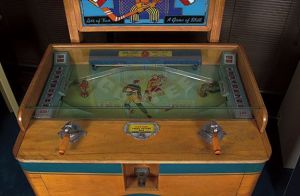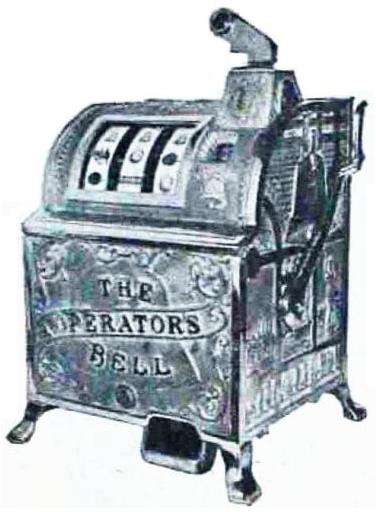The swinging sixties saw the rise of electromechanical slot machines. Bally was the first company to create a slot machine with electric reels, called Money Honey. The game still needed to start with a mechanical lever, but the electric reels were a game changer.
Secure Order FormWe also have:
Beer Barrel Trade Stimulator |
.
.
.
Mills PerfectionPrice: SOLD plus $49 shipping ($59 shipping west of Denver). To Order: use SECURE ORDER FORM Other Inquiries, email: durham@GameRoomAntiques.com |
.
Cent A Pack Circa 1935s, made by Buckley ManufacturingCompany |
.
.
Art Decocirca 1933, made by Garden City Novelty Company and features real cigarette packs in the bottom of the machine | SOLD | SOLD |

.
.
More Trade Stimulators
Decorating Your Gameroom
- Vintage Gas Pumps for Sale
.
.
HISTORY OF TRADE STIMULATORS
Trade stimulators, as the name implies, were designed to stimulate business either by attracting customers into a specific store or by giving the customer another reason to spend his loose change when paying for merchandize.Even though trade stimulators were extensively used in the 1890s, they weren't called trade stimulators until 1907 when the Mills Novelty Company used the term in one of its catalogues.
The most popular early trade stimulators were the Bicycle and the Fairest Wheels. With both of these machines the weight of a penny caused a wheel to rotate and, like a carnival wheel, the player hoped the wheel would stop on a high number so that he could win multiple cigars or other merchandise. Other popular machines during this era were the penny drops and flips.
The bartender or store attendant paid winners over the counter since trade stimulators did not automatically pay out cash like slot machines. Winners usually received free merchandise, such as a cigar or a pack of cigarettes. Some trade stimulators had automatic token dispensers so that the store attendant didn't have to be called every time there was a winner. These tokens were stamped with the store's name or the winning value, such as 'Good For A Free Cigar' or 'Good for 5ó in Trade'.
Although trade stimulators became less popular for a period, their popularity rebounded in the 1930s. Many operators utilized them instead of slot machines because there were lower in cost and smaller in size, as well as needing fewer repairs and posing less legal problems. By the late 1930s, trade stimulators were increasingly becoming known as counter games.
Many trade stimulators, especially those made in the 1930s and 1940s, also dispensed gumball. The gumball feature allowed operators to claim that the stimulators were vending machines and not gambling devices. Operators claimed that the machine were made to dispense gumballs for a coin and that the spinning reels were for amusement purposes.
The 1930s trade stimulators were generally ornate and appealing to the eye, while in the 1940s they became more utilitarian. After the Johnson Act, which made gambling machines illegal, was passed in the early 1950s, merchants started using punchboards instead of trade stimulators.
For a list of trade stimulators available for sale, visit the Trade Stimulator Sales List
For a list of Trade Stimulator Manufacturers and Game Names, visit the Manufacturer and Game List Web PageCopyright: 1996 Ken Durham.
.
.
.
Go back to Sales Lists, Wanted Lists and Trade Lists menu.Go back to GameRoomAntiques
For more information on:Who We Are & Our Privacy Policy
Ken Durham
GameRoomAntiques
Email: durham@GameRoomAntiques.com
Secure Order Form
Gumball slot machine from a Shullsburg, Wisconsin, tavern, 1945
Source: Wisconsin Historical Museum object #2008.13.1A-B
EnlargeDetails of the gumball slot machine, 1945
Detail of the top of the trade stimulator showing the point “payouts” and card values. The yellow section could be flipped forward to hide both the payout information and card windows. Wisconsin Historical Museum object #2008.13.1A-B
EnlargeEvidence tag when it was confiscated
Evidence tag that was attached to the machine shown above after it was confiscated during a raid by the State of Wisconsin. Source: Wisconsin Historical Museum object #2008.13.1C
EnlargeStar Bar and Grill Room with slots, 1942

A Friday night at the Star Bar and Grill Room, at the intersection of Highways 41 and 43 in Kenosha County, April 10, 1942. View the original source document: WHI 34262
EnlargeState officials destroying slot machines, c. 1948
Officials from the state beverage and cigarette tax division destroying slot machines at Law Park in Madison, c. 1948. Investigator L.D. Lewis, who seized the machine featured here, is third from right (wearing apron). View the original source document: WHI 41345
EnlargeSlot seizures in Marathon County, 1924
Wisconsin officials tried for decades to suppress slot machines. Here authorities exhibit slot machines seized during a raid in Marathon County, January 1924. View the original source document: WHI 2288
Trade stimulator gumball slot machine seized from a Shullsburg, Wisconsin tavern in 1945.
(Museum object #2008.13.1A-B)
When is gambling not gambling? When you're buying gum, too. At least that was the theory of many tavern owners. Authorities have tried to ban slot machines almost since they were invented in the late 19th century, and their makers have continually modified the devices to skirt the law. With each nickel, this compact machine not only dispensed a gumball, but also spun five mechanical reels printed with playing card values to produce a poker hand. Players won different numbers of points - redeemable for drinks or cigarettes - for different hands. Because a player purchased a gumball with each pull, the makers claimed that playing did not constitute gambling. Instead, they argued, these amusement devices simply encouraged patrons to spend more money.
The Daval Manufacturing Co., of Chicago, Illinois began making this Ace 'trade stimulator' in 1940. By that time Daval, which had been founded in 1932, was the second largest company specializing in small counter games. Only 6.75 inches high by 6.25 inches wide by 5.5 inches deep, the 'Ace' was ideally sized for whisking out of sight of any authorities who might stop by. But this one wasn't whisked fast enough. It was seized at H.R. Ryan's Tavern in Shullsburg, Wisconsin, on July 17, 1945 by L.D. Lewis, an investigator for the Beverage and Agricultural Tax Division of the Wisconsin Department of the Treasury.
The first coin operated games of chance appeared in the 1870s and required a human attendant - a shopkeeper or bartender - to hand over any indicated winnings. In 1893, San Franciscan Gustav Schultze developed the first recognizably modern slot machine featuring an automatic payout mechanism. Over the next ten years slot machines further evolved and proliferated, becoming commonplace in corner stores and neighborhood taverns as well as in gambling houses.
Not everyone was pleased by their popularity. The machines ran afoul of the often patronizing reform impulse of the late 19th and early 20th centuries. As a democratic form of gambling - available to anyone who could scrape together a few coins - slot machines aroused the movement's desire to protect the lower classes from their own shortcomings. Lawmakers across the country soon attempted to outlaw the machines. San Francisco, where slot machines were born and perfected, banned gaming machines in 1909 and California followed two years later.
Manufacturers, who by then were largely based in Chicago, countered these legal restrictions by turning the slots into 'trade stimulators,' which sold a pack of gum with every pull and replaced cash payouts with merchandise tokens, usually good for drinks or cigars. (Never mind that the gum was usually ignored and the tokens could be exchanged for cash.)
Wisconsin has a long history of opposition to gambling. The state's 1848 constitution banned lotteries and other games of chance, and the legislature repeatedly outlawed betting on other events, including 'numbers,' horse races, and even agricultural futures. Moreover, the Wisconsin courts enforced an extremely strict definition of gambling. They held any activity involving - no matter how remotely - the three elements of chance, a prize, and a 'consideration' (or something of value offered by the participant) to be unconstitutional. This banned virtually all sweepstakes, raffles, and bingo games, along with slot machines and trade stimulators.
Nevertheless, slot machines took firm root in Wisconsin during Prohibition. Slot machine companies, some reputedly operated by organized crime, typically leased the machines to club owners or shopkeepers, who kept a share of the profits. When the Depression arrived a few years later, slot machine income kept many small businesses (and after Prohibition, taverns) afloat. The machines became especially popular in the state's northern resort areas, where vacationers evidently felt the machines added an extra element of fun and excitement to their visits. In 1945, at least 45,000 slot machines were operating in Wisconsin - the most in the nation.
Slot Machine For Sale
Besides their traditional moral reservations, state leaders began to worry that popular acceptance of the 'one-armed bandits' was fostering a widespread disrespect for the law, and that the illegal profits they generated were beginning to corrupt local government and law enforcement. In response to these threats, future Governor Vernon Thomson introduced legislation to clamp down on the problem. To circumvent local authorities who might be reluctant to harass their own neighbors, the legislation granted enforcement powers to the State Beverage Tax Commission, which could revoke the liquor license of any establishment caught operating slot machines for a period of one year.
This gumball trade simulator was confiscated just six weeks after the 'Thompson Anti-Gambling Law' took effect in June 1945. According to the Shullsburg newspaper Pick and Gad, H. R. Ryan and his partners had applied to the Shullsburg City Council for a Retail Intoxicating Liquor License Class B only a few weeks earlier, on June 19. The Council approved their application on July 3, when it received the group's required bond. The first raids under the new anti-gambling statute took place the following day in Racine.
Herbert R. Ryan was born about 1895 in Jordan (Green County), Wisconsin to farmers John and Mary Ryan. He married Edna Vick around 1922 and by 1930 the couple operated a farm in Willow Springs (Lafayette County) with their children Virgil, Kathleen, and Rose. Herbert was about 50 years old and had been farming all his adult life when he became part-owner of the Shullsburg tavern. He may have viewed the tavern as a future source of retirement income. If so, the seizure of this machine a mere two weeks after opening for business probably came as a shock. This trade stimulator was admitted as 'exhibit 10' in a hearing before the Fifth Judicial Circuit Court held on September 19, 1945. It is not known whether the seizure cost Ryan and his partners their brand new liquor license, but evidently it did not deter him from continuing in the business. Ryan owned or operated several other taverns in Shullsburg in subsequent years.
Learn More
Have Questions?
History Of Keeney Slot Machine Company Inc
For more information or to purchase an image of one of the objects featured in Curators' Favorites, contact our staff by email below:
History Of Keeney Slot Machine Company In Austin Texas
[Sources: Holy, Richard. The Control of Gambling in Wisconsin (Madison; Wisconsin Legislative Reference Library, 1956); Bueschel, Richard M. Collector's Guide to Vintage Coin Machines (Atglen, PA; Schiffer Publishing, Ltd., 1995); Fey, Marshall. Slot Machines: An Illustrated History of America's Most Popular Coin-Operated Gaming Device (Las Vegas; Nevada Publications, 1983).]
DBD
History Of Keeney Slot Machine Company In Illinois
Posted on May 22, 2008